 |
| AP Board Class 10 Maths Chapter 13 Probability Ex 13.2 Textbook Solutions PDF: Download Andhra Pradesh Board STD 10th Maths Chapter 13 Probability Ex 13.2 Book Answers |
Andhra Pradesh Board Class 10th Maths Chapter 13 Probability Ex 13.2 Textbooks Solutions PDF
Andhra Pradesh State Board STD 10th Maths Chapter 13 Probability Ex 13.2 Books Solutions with Answers are prepared and published by the Andhra Pradesh Board Publishers. It is an autonomous organization to advise and assist qualitative improvements in school education. If you are in search of AP Board Class 10th Maths Chapter 13 Probability Ex 13.2 Books Answers Solutions, then you are in the right place. Here is a complete hub of Andhra Pradesh State Board Class 10th Maths Chapter 13 Probability Ex 13.2 solutions that are available here for free PDF downloads to help students for their adequate preparation. You can find all the subjects of Andhra Pradesh Board STD 10th Maths Chapter 13 Probability Ex 13.2 Textbooks. These Andhra Pradesh State Board Class 10th Maths Chapter 13 Probability Ex 13.2 Textbooks Solutions English PDF will be helpful for effective education, and a maximum number of questions in exams are chosen from Andhra Pradesh Board.Andhra Pradesh State Board Class 10th Maths Chapter 13 Probability Ex 13.2 Books Solutions
| Board | AP Board |
| Materials | Textbook Solutions/Guide |
| Format | DOC/PDF |
| Class | 10th |
| Subject | Maths |
| Chapters | Maths Chapter 13 Probability Ex 13.2 |
| Provider | Hsslive |
How to download Andhra Pradesh Board Class 10th Maths Chapter 13 Probability Ex 13.2 Textbook Solutions Answers PDF Online?
- Visit our website - Hsslive
- Click on the Andhra Pradesh Board Class 10th Maths Chapter 13 Probability Ex 13.2 Answers.
- Look for your Andhra Pradesh Board STD 10th Maths Chapter 13 Probability Ex 13.2 Textbooks PDF.
- Now download or read the Andhra Pradesh Board Class 10th Maths Chapter 13 Probability Ex 13.2 Textbook Solutions for PDF Free.
AP Board Class 10th Maths Chapter 13 Probability Ex 13.2 Textbooks Solutions with Answer PDF Download
Find below the list of all AP Board Class 10th Maths Chapter 13 Probability Ex 13.2 Textbook Solutions for PDF’s for you to download and prepare for the upcoming exams:10th Class Maths 13th Lesson Probability Ex 13.2 Textbook Questions and Answers
Question 1.
A bag contains 3 red balls and 5 black balls. A ball is drawn at random from the bag. What is the probability that the ball drawn is (i) red ? (ii) not red?
Answer:
i) Total number of balls in the bag = 3 red + 5 black = 8 balls.
Number of total outcomes when a ball is drawn at random = 3 + 5 = 8
Now, number of favourable outcomes of red ball = 3.
∴ Probability of getting a red ball = No. of favourable outcomes No. of total outcomes = 38
ii) If P( E) is the probability of drawing no red ball, then P(E) + P(E⎯⎯⎯⎯) = 1
P(E⎯⎯⎯⎯) = 1 – P(E)= 1 – 38 = 58
Question 2.
A box contains 5 red marbles, 8 white marbles and 4 green marbles. One marble is taken out of the box at random. What is the probability that the marble taken out will be (i) red? (ii) white? (iii) not green?
Answer:
Total number of marbles in the box = 5 red + 8 white + 4 green = 5 + 8 + 4= 17
Number of total outcomes in drawing a marble at random from the box =17.
i) Number of red marbles = 5
Number of favourable outcomes in drawing a red ball = 5
∴ Probability of getting a red ball P(R) = No. of favourable outcomes No. of total outcomes
P(R) = 517
ii) Number of white marbles = 8
Number of favourable outcomes in drawing a white marble = 8
∴ Probability of getting a white marble
P(W) = 817
iii) Number of ‘non-green’ marbles = 5 red + 8 white = 5 + 8 = 13
Number of outcomes favourable to drawing a non-green marble =13.
∴ Probability of getting a non- green marble
P(non – green) = No. of favourable outcomes No. of total outcomes
P(non – green) = 1317
Probability of getting a green ball = No. of green balls Total no. of balls = 417
Now P(G) = 417
and P(G) + P(G⎯⎯⎯⎯) = 1
∴ P(G⎯⎯⎯⎯) = 1 – P(G)
= 1 – 417
= 1317
Question 3.
A Kiddy bank contains hundred 50p coins, fifty Rs. 1 coins, twenty Rs. 2 coins and ten Rs. 5 coins. If it is equally likely that one of the coins will fall out when the bank is turned upside down, what is the probability that the coin (i) will be a 50 p coin? (ii) will not be a Rs. 5 coin?
Answer:
i) Number of 50 p coins = 100
Number of Rs. 1 coins = 50
Number of Rs. 2 coins = 20
Number of Rs. 5 coins = 10
Total number of coins = 180
Number of total outcomes for a coin to fall down = 180.
Number of outcomes favourable to 50 p coins to fall down = 100.
∴ Probability of a 50 p coin to fall down = No. of favourable outcomes No. of total outcomes
= 100180 = 59
ii) Let P(E) be the probability for a Rs. 5 coin to fall down.
Number of outcomes favourable to Rs. 5 coin = 10.
∴ Probability for a Rs. 5 coin to fall down = No. of favourable outcomes No. of total outcomes
= 10180 = 118
Then P(E⎯⎯⎯⎯) is the probability of a coin which fall down is not a Rs. 5 coin.
Again P(E) + P(E⎯⎯⎯⎯) = 1
∴ P(E⎯⎯⎯⎯)= l-P(E)
= 1 – 118
= 1718.
Question 4.
Gopi buys a fish from a shop for his aquarium. The shopkeeper takes out one fish at random from a tank containing 5 male fish and 8 female fish (See figure). What is the probability that the fish taken out is a male fish? Answer:
Answer:
Number of male fish = 5
Number of female fish = 8
Total number of fish = 5 m + 8 f
= 13 fishes.
∴ Number of total outcomes in taking a fish at random from the aquarium =13.
Number of male fish = 5
∴ Number of outcomes favourable to male fish = 5.
∴ The probability of taking a male fish = No. of favourable outcomes No. of total outcomes
= 513
= 0.38
Question 5.
A game of chance consists of spinning an arrow which comes to rest pointing at one of the numbers 1, 2, 3, 4, 5, 6, 7, 8 (See figure), and these are equally likely outcomes. What is the probability that it will point at
(i) 8?
(ii) an odd number?
(iii) a number greater than 2?
(iv) a number less than 9?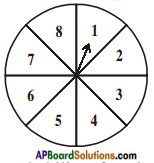
Answer:
Number of total outcomes are (1,2,……….., 8) = 8
i) Number of outcomes favourable to 8 = 1.
∴ P(8) = No. of favourable outcomes No. of total outcomes
= 18
ii) Number of ‘odd numbers’ on the spinning wheel = (1, 3, 5, 7) = 4
∴ Number of outcomes favourable to an odd number.
∴ Probability of getting an odd number = No. of favourable outcomes No. of total outcomes
= 48 = 12
iii) Number greater than 2 are (3, 4, 5, 6, 7, 8)
Number of outcomes favourable to ‘greater than 2’ are = 6.
Probability of pointing a number greater than 2
P(E) = No. of favourable outcomes No. of total outcomes
= 68 = 34
iv) Number less than 9 are: (1,2, 3, 4, 5, 6, 7, 8 …… 8)
∴ Number of outcomes favourable to pointing a number less than 9 = 8.
∴ Probability of a number less than 9
P(E) = No. of outcomes favourable to less than 9 No.of total outcomes
= 88 = 1
Note : This is a sure event and hence probability is 1.
Question 6.
One card is drawn from, a well-shuffled deck of 52 cards. Find the probability of getting
(i) a king of red colour
(ii) a face card
(iii) a red face card
(iv) the jack of hearts
(v) a spade
(vi) the queen of diamonds.
Answer:
Total number of cards = 52.
∴ Number of all possible outcomes in drawing a card at random = 52.
i) Number of outcomes favourable to the king of red colour = 2(♥ K, ♦ K)
∴ Probability of getting the king of red colour
P(E) = No. of favourable outcomes No. of total outcomes
= 252 = 126
ii) Number of face cards in a deck of cards = 4 × 3 = 12 (K, Q, J)
Number of outcomes favourable to select a face card = 12.
∴ Probability of getting a face card
= No. of favourable outcomes No. of total outcomes
= 1252 = 313
iii) Number of red face cards = 2 × 3 = 6.
∴ Number of outcomes favourable to select a red face card = 6.
∴ Probability of getting a red face
= No. of favourable outcomes No. of total outcomes
= 652 = 326
iv) Number of outcomes favourable to the jack of hearts = 1.
∴ Probability of getting jack of hearts
= No. of favourable outcomes No. of total outcomes
= 152
v) Number of spade cards = 13
∴ Number of outcomes favourable to ‘a spade card’ = 13.
∴ Probability of drawing a spade
= No. of favourable outcomes No. of total outcomes
= 1352 = 14
vi) Number of outcomes favourable to the queen of diamonds = 1.
∴ Probability of drawing the queen of diamonds
= No. of favourable outcomes No. of total outcomes
= 152
Question 7.
Five cards-the ten, jack, queen, king and ace of diamonds, are well-shuffled with their face downwards. One card is then picked up at random.
i) What is the probability that the card is the queen?
ii) If the queen is drawn and put aside, what is the probability that the second card picked is (a) an ace? (b) a queen?
Answer:
Total number of cards = 5.
∴ Number of total outcomes in picking up a card at random = 5.
i) Number of outcomes favourable to queen = 1.
∴ Probability of getting the queen
= No.of outcomes favourable to the ‘Q’ No.of total outcomes
= 15
ii) When queen is drawn and put aside, remaining cards are four.
∴ Number of total outcomes in drawing a card at random = 4.
a) Number of favourable outcomes to ace 1
Probability of getting an ace
= No. of favourable outcomes No. of total outcomes
= 14
b) Number of favourable outcomes to ‘Q’ = 0 (as it was already drawn and put aside)
∴ Probability that the card is Q = 04 = 0
After putting queen aside, selecting the queen from the rest is an impossible event and hence the probability is zero.
Question 8.
12 defective pens are accidentally mixed with 132 good ones. It is not possible to just look at a pen and tell whether or not it is defective. One pen is taken out at random from this lot. Determine the probability that the pen taken out is a good one.
Answer:
Number of good pens = 132
Number of defective pens = 12
Total number of pens = 132 + 12 = 144
∴ Total number of outcomes in taking a pen at random = 144.
No. of favourable outcomes in taking a good pen = 132.
∴ Probability of taking a good pen
= No. of favourable outcomes No. of total outcomes
= 132144 = 1112
Question 9.
A lot of 20 bulbs contain 4 defective ones. One bulb is drawn at random from the lot. What is the probability that this bulb is defective? Suppose the bulb drawn in previous case is not defective and is not replaced. Now one bulb is drawn at random from the rest. What is the probability that this bulb is not defective?
Answer:
Given :
4 out of 20 bulbs are defective
(i.e.) Number of defective bulbs = 4
Number of non-defective bulbs = 20 – 4 = 16
If a bulb is drawn at random, the total outcomes are = 20
Number of outcomes favourable to ‘defective bulb’ = 4
∴ Probability of getting a defective bulb
= No. of favourable outcomes No. of total outcomes
= 420 = 15
Suppose a non-defective bulb is drawn and not replaced, then the bulbs remaining are = 19
∴ Total outcomes in drawing a bulb from the rest = 19
Number of favourable outcomes in drawing non-defective bulb from the rest = 16 – 1 = 15
∴ Probability of getting a non-defective bulb in the second draw
= No. of favourable outcomes No. of total outcomes
= 1519
Question 10.
A box contains 90 discs which are numbered from 1 to 90. If one disc is drawn at random from the box, find the probability that it bears
(i) a two digit number
(ii) a perfect square number
(iii) a number divisible by 5.
Answer:
Total number of discs in the box = 90
∴ Number of total outcomes in drawing a disc at random from the box = 90.
i) Number of 2-digit numbers in the box (10, 11,….., 90) = 81
i.e., Number of favourable outcomes in drawing a 2 – digit numbers = 81
∴ Probability of selecting a disc bearing a 2 – digit number
= No. of favourable outcomes No. of total outcomes
= 8190 = 910 = 0.9
ii) Number of perfect squares in the box (12 = 1, 22 = 4, 32 = 9, 42 = 16, 52 = 25, 62 = 36, 72 = 49, 82 = 64 and 92 = 81) = 9
i.e., Number of favourable out-comes in drawning a disc bearing a perfect square = 9
∴ Probability of drawning a disc with a perfect square
= No. of favourable outcomes No. of total outcomes
= 990 = 110
iii) Number of multiples of 5 from 1 to 90 are (5, 10, 15, ……….., 90) = 18
i.e., Number of favourable outcomes in drawing a disc with a multiple of 5 = 18
∴ Probability of drawing a disc bearing a number divisible by 5
= No. of favourable outcomes No. of total outcomes
= 1890 = 15
Question 11.
Suppose you drop a die at random on the rectangular region shown in figure. What is the probability that it will land inside the circle with diameter 1 m?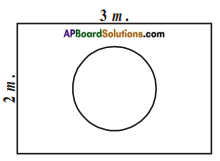
Answer:
3 m.
Length of the given rectangle = 3 m.
and its breadth = 2 m.
Area of the rectangle
= length × breadth = 3 × 2 = 6 m2
∴ Total area of the region for landing = 6 m2.
Diameter of the given circle = 1 m.
Area of the circle = 𝜋d24
= 227×1×14[ or 𝜋𝑟2=227×12×12]
= 2228
∴ Probability of the coin to land on the circle
= 22286
= 2228×6
= 1128×3
= 1184
Question 12.
A lot consists of 144 ball pens of which 20 are defective and the others are good. The shopkeeper draws one pen at random and gives it to Sudha. What is the probability that (i) She will buy it? (ii) She will not buy it?
Answer:
Given : 20 out of 144 are defective i.e., no. of defective ball pens = 20
no. of good ball pens = 144 – 20 = 124
∴ Total outcomes in drawing a ball pen at random = 144.
i) Sudha buys it if it is not defective / a good one.
No. of outcomes favourable to a good pen = 124.
∴ Probability of buying it
= No. of favourable outcomes No. of total outcomes
= 124144 = 3136
ii) Sudha will not buy it-if it is a defective pen
No. of outcomes favourable to a defective pen = 20
∴ Probability of not buying it
= No. of favourable outcomes No. of total outcomes
= 20144 = 536
!! (not buying) = 1 – P (buying)
= 1 – 3136 = 536
Question 13.
Two dice are rolled simultaneously and counts are added
(i) Complete the table given below:
(ii) A student argues that ‘there are 11 possible outcomes 2, 3, 4, 5, 6, 7, 8, 9, 10, 11 and 12. Therefore, each of them has a probability 111. Do you agree with this argument? Justify your answer.
Answer:
When two dice are rolled, total number of outcomes = 36 (see the given table).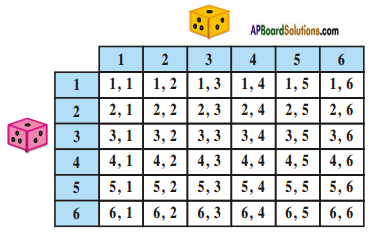 (i)
(i)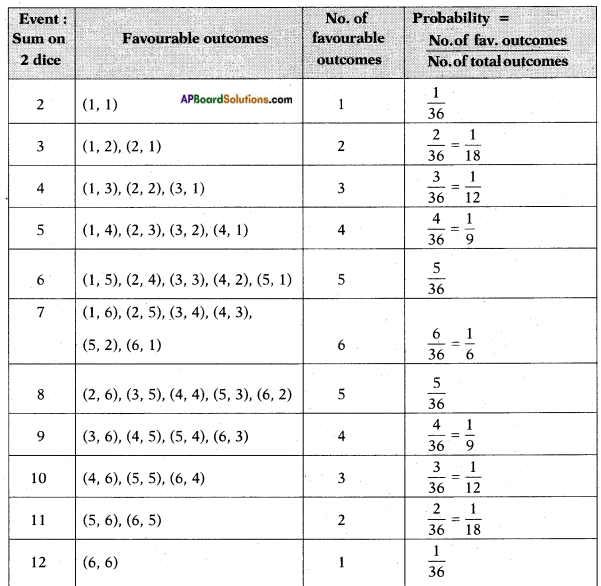 (ii) The above (given) argument is wrong [from the above table].
(ii) The above (given) argument is wrong [from the above table].
The sum 2, 3, 4, ………… and 12 have different no. of favourable outcomes, moreover total number of outcomes are 36.
Question 14.
A game consists of tossing a one rupee coin 3 times and noting its outcome each time. Hanif wins if all the tosses give the same result i.e., three heads or three tails, and loses otherwise. Calculate the probability that Hanif will lose the game.
Answer:
When a coin is tossed for n – times, the total number of outcomes = 2n.
∴ If a coin is tossed for 3 – times, then the total number of outcomes = 23 = 8
Note the following :
TTT
TTH
THT
HTT
HHT
HTH
THH
HHH
Of the above, no. of outcomes with different results = 6.
Probability of losing the game
= No. of favourable outcomes to lose No. of total outcomes
= 68 = 34
Question 15.
A dice is thrown twice. What is the probability that (i) 5 will not come up either time? (ii) 5 will come up atleast once? [Hint : Throwing a dice twice and throwing two dice simultaneously are treated as the same experiment].
Answer:
If a dice is thrown n-times or n-dice are thrown simultaneously then the total
number of outcomes = 6×6×6….×6
(n – times) = 6n.
No. of total outcomes in throwing a dice for two times = 62 = 36. i) Let E be the event that 5 will not come up either time, then the favourable outcomes are
i) Let E be the event that 5 will not come up either time, then the favourable outcomes are
(1, 1), (1, 2), (1, 3), (1, 4), (1, 6), (2, 1), (2, 2), (2, 3), (2, 4), (2, 6), (3, 1), (3/2), (3, 3), (3, 4), (3, 6), (4, 1), (4, 2), (4, 3), (4, 4), (4, 6), (6, 1), (6, 2), (6, 3), (6, 4), (6, 6) = 25.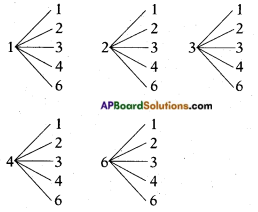 ∴ P(E) = No. of favourable outcomes No. of total outcomes
∴ P(E) = No. of favourable outcomes No. of total outcomes
= 2536
ii) Let E be the event that 5 will come up atleast once.
Then the favourable outcomes are (1,5), (2, 5), (3, 5), (4, 5), (5, 5), (6, 5), (5, 1), (5, 2), (5, 3), (5, 4), (5, 6) = 11 No. of favourable outcomes = 11
∴ P(E) = No. of favourable outcomes No. of total outcomes
AP Board Textbook Solutions PDF for Class 10th Maths
- AP Board Class 10 Maths Chapter 1 Real Numbers Ex 1.1 Textbook Solutions PDF
- AP Board Class 10 Maths Chapter 1 Real Numbers Ex 1.2 Textbook Solutions PDF
- AP Board Class 10 Maths Chapter 1 Real Numbers Ex 1.3 Textbook Solutions PDF
- AP Board Class 10 Maths Chapter 1 Real Numbers Ex 1.4 Textbook Solutions PDF
- AP Board Class 10 Maths Chapter 1 Real Numbers Ex 1.5 Textbook Solutions PDF
- AP Board Class 10 Maths Chapter 1 Real Numbers Optional Exercise Textbook Solutions PDF
- AP Board Class 10 Maths Chapter 1 Real Numbers InText Questions Textbook Solutions PDF
- AP Board Class 10 Maths Chapter 2 Sets Ex 2.1 Textbook Solutions PDF
- AP Board Class 10 Maths Chapter 2 Sets Ex 2.2 Textbook Solutions PDF
- AP Board Class 10 Maths Chapter 2 Sets Ex 2.3 Textbook Solutions PDF
- AP Board Class 10 Maths Chapter 2 Sets Ex 2.4 Textbook Solutions PDF
- AP Board Class 10 Maths Chapter 2 Sets InText Questions Textbook Solutions PDF
- AP Board Class 10 Maths Chapter 3 Polynomials Ex 3.1 Textbook Solutions PDF
- AP Board Class 10 Maths Chapter 3 Polynomials Ex 3.2 Textbook Solutions PDF
- AP Board Class 10 Maths Chapter 3 Polynomials Ex 3.3 Textbook Solutions PDF
- AP Board Class 10 Maths Chapter 3 Polynomials Ex 3.4 Textbook Solutions PDF
- AP Board Class 10 Maths Chapter 3 Polynomials Optional Exercise Textbook Solutions PDF
- AP Board Class 10 Maths Chapter 3 Polynomials InText Questions Textbook Solutions PDF
- AP Board Class 10 Maths Chapter 4 Pair of Linear Equations in Two Variables Ex 4.1 Textbook Solutions PDF
- AP Board Class 10 Maths Chapter 4 Pair of Linear Equations in Two Variables Ex 4.2 Textbook Solutions PDF
- AP Board Class 10 Maths Chapter 4 Pair of Linear Equations in Two Variables Ex 4.3 Textbook Solutions PDF
- AP Board Class 10 Maths Chapter 4 Pair of Linear Equations in Two Variables Optional Exercise Textbook Solutions PDF
- AP Board Class 10 Maths Chapter 4 Pair of Linear Equations in Two Variables InText Questions Textbook Solutions PDF
- AP Board Class 10 Maths Chapter 5 Quadratic Equations Ex 5.1 Textbook Solutions PDF
- AP Board Class 10 Maths Chapter 5 Quadratic Equations Ex 5.2 Textbook Solutions PDF
- AP Board Class 10 Maths Chapter 5 Quadratic Equations Ex 5.3 Textbook Solutions PDF
- AP Board Class 10 Maths Chapter 5 Quadratic Equations Ex 5.4 Textbook Solutions PDF
- AP Board Class 10 Maths Chapter 5 Quadratic Equations Optional Exercise Textbook Solutions PDF
- AP Board Class 10 Maths Chapter 5 Quadratic Equations InText Questions Textbook Solutions PDF
- AP Board Class 10 Maths Chapter 6 Progressions Ex 6.1 Textbook Solutions PDF
- AP Board Class 10 Maths Chapter 6 Progressions Ex 6.2 Textbook Solutions PDF
- AP Board Class 10 Maths Chapter 6 Progressions Ex 6.3 Textbook Solutions PDF
- AP Board Class 10 Maths Chapter 6 Progressions Ex 6.4 Textbook Solutions PDF
- AP Board Class 10 Maths Chapter 6 Progressions Ex 6.5 Textbook Solutions PDF
- AP Board Class 10 Maths Chapter 6 Progressions Optional Exercise Textbook Solutions PDF
- AP Board Class 10 Maths Chapter 6 Progressions InText Questions Textbook Solutions PDF
- AP Board Class 10 Maths Chapter 7 Coordinate Geometry Ex 7.1 Textbook Solutions PDF
- AP Board Class 10 Maths Chapter 7 Coordinate Geometry Ex 7.2 Textbook Solutions PDF
- AP Board Class 10 Maths Chapter 7 Coordinate Geometry Ex 7.3 Textbook Solutions PDF
- AP Board Class 10 Maths Chapter 7 Coordinate Geometry Ex 7.4 Textbook Solutions PDF
- AP Board Class 10 Maths Chapter 7 Coordinate Geometry Optional Exercise Textbook Solutions PDF
- AP Board Class 10 Maths Chapter 7 Coordinate Geometry InText Questions Textbook Solutions PDF
- AP Board Class 10 Maths Chapter 8 Similar Triangles Ex 8.1 Textbook Solutions PDF
- AP Board Class 10 Maths Chapter 8 Similar Triangles Ex 8.2 Textbook Solutions PDF
- AP Board Class 10 Maths Chapter 8 Similar Triangles Ex 8.3 Textbook Solutions PDF
- AP Board Class 10 Maths Chapter 8 Similar Triangles Ex 8.4 Textbook Solutions PDF
- AP Board Class 10 Maths Chapter 8 Similar Triangles Optional Exercise Textbook Solutions PDF
- AP Board Class 10 Maths Chapter 8 Similar Triangles InText Questions Textbook Solutions PDF
- AP Board Class 10 Maths Chapter 9 Tangents and Secants to a Circle Ex 9.1 Textbook Solutions PDF
- AP Board Class 10 Maths Chapter 9 Tangents and Secants to a Circle Ex 9.2 Textbook Solutions PDF
- AP Board Class 10 Maths Chapter 9 Tangents and Secants to a Circle Ex 9.3 Textbook Solutions PDF
- AP Board Class 10 Maths Chapter 9 Tangents and Secants to a Circle Optional Exercise Textbook Solutions PDF
- AP Board Class 10 Maths Chapter 9 Tangents and Secants to a Circle InText Questions Textbook Solutions PDF
- AP Board Class 10 Maths Chapter 10 Mensuration Ex 10.1 Textbook Solutions PDF
- AP Board Class 10 Maths Chapter 10 Mensuration Ex 10.2 Textbook Solutions PDF
- AP Board Class 10 Maths Chapter 10 Mensuration Ex 10.3 Textbook Solutions PDF
- AP Board Class 10 Maths Chapter 10 Mensuration Ex 10.4 Textbook Solutions PDF
- AP Board Class 10 Maths Chapter 10 Mensuration Optional Exercise Textbook Solutions PDF
- AP Board Class 10 Maths Chapter 10 Mensuration InText Questions Textbook Solutions PDF
- AP Board Class 10 Maths Chapter 11 Trigonometry Ex 11.1 Textbook Solutions PDF
- AP Board Class 10 Maths Chapter 11 Trigonometry Ex 11.2 Textbook Solutions PDF
- AP Board Class 10 Maths Chapter 11 Trigonometry Ex 11.3 Textbook Solutions PDF
- AP Board Class 10 Maths Chapter 11 Trigonometry Ex 11.4 Textbook Solutions PDF
- AP Board Class 10 Maths Chapter 11 Trigonometry Optional Exercise Textbook Solutions PDF
- AP Board Class 10 Maths Chapter 11 Trigonometry InText Questions Textbook Solutions PDF
- AP Board Class 10 Maths Chapter 12 Applications of Trigonometry Ex 12.1 Textbook Solutions PDF
- AP Board Class 10 Maths Chapter 12 Applications of Trigonometry Ex 12.2 Textbook Solutions PDF
- AP Board Class 10 Maths Chapter 12 Applications of Trigonometry Optional Exercise Textbook Solutions PDF
- AP Board Class 10 Maths Chapter 12 Applications of Trigonometry InText Questions Textbook Solutions PDF
- AP Board Class 10 Maths Chapter 13 Probability Ex 13.1 Textbook Solutions PDF
- AP Board Class 10 Maths Chapter 13 Probability Ex 13.2 Textbook Solutions PDF
- AP Board Class 10 Maths Chapter 13 Probability Optional Exercise Textbook Solutions PDF
- AP Board Class 10 Maths Chapter 13 Probability InText Questions Textbook Solutions PDF
- AP Board Class 10 Maths Chapter 14 Statistics Ex 14.1 Textbook Solutions PDF
- AP Board Class 10 Maths Chapter 14 Statistics Ex 14.2 Textbook Solutions PDF
- AP Board Class 10 Maths Chapter 14 Statistics Ex 14.3 Textbook Solutions PDF
- AP Board Class 10 Maths Chapter 14 Statistics Ex 14.4 Textbook Solutions PDF
- AP Board Class 10 Maths Chapter 14 Statistics InText Questions Textbook Solutions PDF







0 Comments:
Post a Comment